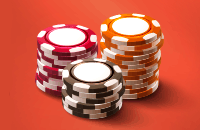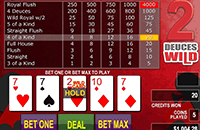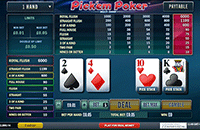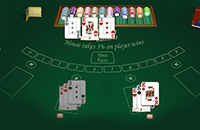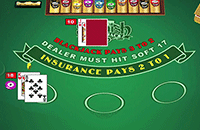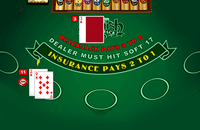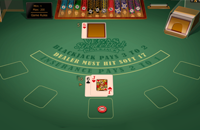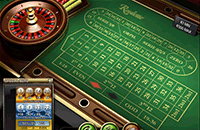Chemin De Fer Baccarat – Rules Strategy & Tips
How to Play Chemin De Fer
Chemin De Fer otherwise known as French Baccarat is a form of Baccarat where players bet against another player.
Instead of player versus banker as in other forms of the game, in Chemin De Fer or French Baccarat, one player takes on the role of the banker each hand and risks their own money against other players at the table. The casino takes a percentage of winning bets as their ‘fee’ to ensure they make money as well.
The remaining rules of the game are like other Baccarat variants.
A typical screenshot of a game of Chemin De Fer (French Baccarat) is shown above. Note the number of players with a bet at the table. The banker needs to match all these bets in order for them all to count.
Chemin De Fer Rules
A standard game is played with 6 decks of cards and can feature anywhere between 8 and 12 players.
At the start of the game, the player to the right of the croupier has the choice to become the banker. All others at the table are deemed as players and can only bet on the player to win.
If the player to the right of the croupier agrees to be the banker for that hand, they decide how much of their own money they are prepared to risk. They are able to pass on being the banker if they wish, in which case the next player to the right of the croupier is offered the choice.
Once the banker has decided how much they are willing to risk, play continues to all other players who make their bet.
Once all players have made a bet, if the amount exceeds the amount the banker is prepared to risk, they can either increase the amount to match the other players or stick with what they agreed. In the case of the latter, the last bets to be placed are removed from the table until the 2 amounts are equal. The earlier you place your bet as a player, the more chance you have of it being covered.
If the banker is prepared to risk more than the players at the table, in a land-based casino any spectators have the chance to place a bet as well.
Once bets have been placed, the player with the highest bet gets to act as the player against the banker. In the event of 2 or more players having an equal highest bet, the player who placed their bet first gets to decide what happens during the hand.
2 cards are now dealt – face down – to the player and to the banker.
They both now look at their cards in secret, not allowing the other to view their hand. The player can show the other players if they wish.
It is worth reminding you at this point that the scoring is the same as all other forms of Baccarat. Aces are worth 1 point, 10, and picture cards 0 points, and all numbers are of equal value to their pips. If the total is 10 or more, only the last digit counts. The aim is to get as high total as you can with 9 or 19 as this counts as 9 as well. The best hand possible.
If either has a hand worth 8 or 9 points, they turn the cards over and the hand ends. The highest total wins.
If neither the banker nor the player has an 8 or 9, the player now has a choice to make. Unlike in other versions of Baccarat, the player can choose whether or not to take the 3rd card.
However, there are rules which should be adhered to in the game as you act for a number of other players as well, and detouring from it can be frowned upon if you lose.
The Players Rule
| Total | Player action |
|---|---|
| 0 to 4 | Draw a card |
| 5 | Draw or stand |
| 6 or 7 | Stand |
| 8 or 9 | Hand over before 3rd card taken |
Only really when a player has a total of 5 do they get to choose whether or not to draw a 3rd card, it is down to the player in charge of the hand to make this decision.
If the player draws a 3rd card, it is dealt face up so the banker can also see the extra card.
Although the banker has the decision as to whether to take a 3rd card, there is also a general consensus as to what they should do with only 2 cases of the banker deciding what to do. The table below gives further information on this:
| Banker total | Banker Draws | Banker Stands | Up to Banker |
|---|---|---|---|
| 0 to 2 | Always Draws | Never | |
| 3 | If player 3rd card is 1 to 7 or 10 | If player 3rd card is 8 | If player 3rd card is 9 |
| 4 | If player 3rd card is 2 to 7 | If player 3rd card is 0,1,8 or 9 | |
| 5 | If player 3rd card is 5 to 7 | If player 3rd card is 0,1,2,3,8 or 9 | If player 3rd card is 4 |
| 6 | If player 3rd card is 6 or 7 | If player 3rd card is 0 to 5 or 8 or 9 | |
| 7 | Never | Always Stands | |
| 8 or 9 | No 3rd card drawn | No 3rd card drawn |
**If the Player stands, the Banker should draw a 3rd card with a total of 0 to 5 and stand on 6 or 7
Once all cards have been dealt, both hands are turned over and winnings paid. If the player has a higher total, all players whose bets were accepted are paid out at 1 to 1 from the funds set aside by the banker.
If the banker has the higher hand, the banker wins all the player bets less 5% which is paid to the casino.
In the event of a tie, the bets are left on the table and paid out the following hand when either the player or banker wins.
As you can see, being the banker means you can potentially win a higher amount than when you are a player, however, you do risk more in this position too as you are potentially betting against several players at any one time.
Once a hand has finished, the banker has the chance to remain as the banker for the next hand. They will need to risk more funds in order to do this or pass it on to the next player. It is considered bad practice in Chemin De Fer and French Baccarat to give up the banker position if you win after the 1st hand, players should have at least one opportunity to win their money back. If the banker wins 3 or 4 times in a row, it is acceptable for them to allow the next player to replace them as the banker.
Chemin De Fer Strategy
Chemin De Fer/ French Baccarat strategy is the same as for the majority of the versions of baccarat. The player should take a further card when they have a total of 0 to 4 and stand if they have a 6 or 7. They have to stand on a total of 8 and 9 anyway so it is really just a total of 5 where they have a choice.
If the player stands, the banker should take a card with a total of 0 to 5 and stand on 7.
If the player takes a card, the banker should do the following when determining if they should take the 3rd card:
Player
| Banker | 0 | 1 | 2 | 3 | 4 | 5 | 6 | 7 | 8 | 9 |
|---|---|---|---|---|---|---|---|---|---|---|
| 7 | S | S | S | S | S | S | S | S | S | S |
| 6 | S | S | S | S | S | S | H | H | S | S |
| 5 | S | S | S | S | ? | H | H | H | S | S |
| 4 | S | S | H | H | H | H | H | H | S | S |
| 3 | H | H | H | H | H | H | H | H | S | ? |
| 2 | H | H | H | H | H | H | H | H | H | H |
| 1 | H | H | H | H | H | H | H | H | H | H |
| 0 | H | H | H | H | H | H | H | H | H | H |
The only situations dependent on what the player did are:
•If the player has a 5
•If the banker has a 6 and the player stood
•If the banker has a 5 and player hit and got a 4
•If the banker has a 3 and player hit and got a 9
In the above cases, the banker should copy the player’s actions and stand when they stand and hit when they hit. From the player point of view, they should mix it up whether they stand or hit on a 5 to confuse the banker, this gives them the best chance of winning the hand.
Chemin De Fer Tips
• Always check the odds at the tables. Some casinos offer better odds than others so check out our recommended casinos for where to play.
• Quit when you are ahead. It is very easy to get caught up in the game and think you are unbeatable only to go on a losing streak and lose the money you won. Have a target before you start to play and stick to it.
• Play short sessions. The casino will usually win in the long run. In theory, the longer you play the more chance you have of finishing with a loss.
• Manage your bankroll. To ensure the best possible amount of fun from a session break your bankroll down into a good number of bets and stick to this amount.
• Don’t chase losses. If you do have a losing session, it is tempting to deposit more to try and win back some of what you lost. This is a very bad idea in any casino game and should be avoided at all costs
Related Articles :
Baccarat Strategy
How to Play EZ Baccarat
How to Play European Baccarat

